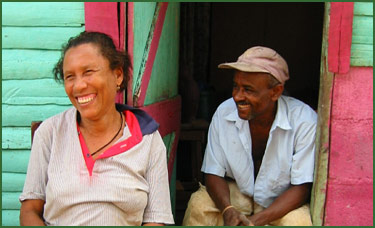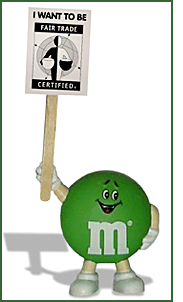Bittersweet Chocolate
By Murray MacAdam
 Ovidia and Ovispo, cocoa farmers in Dominican Republic.
Ovidia and Ovispo, cocoa farmers in Dominican Republic.
Many Third World farmers who grow the appetizing cocoa bean live in absolute poverty. But 'fair trade' can make chocolate taste better for both producer and consumer.
It is a simple but sublime culinary pleasure. Peel back the foil wrapper, take a bite and savour the potent sweetness of chocolate.
Breathe in the 400 distinct smells that emanate from the cocoa bean, chocolate's key ingredient. A rose, in contrast, has only 14.
But don't think about how the cocoa was grown, or that chocolate bar might taste bittersweet. Many of the Third World farmers who pick the aromatic cocoa live in absolute poverty.
An International Institute of Tropical Agriculture (IITA) study in 2002 found that the average wage for cocoa growers in West Africa ranged from U.S.$30 to $110 - and that's for the entire year. These meager earnings, the report concludes, make it very tough for families to meet their basic needs, and for small businesses and communities to survive.
"The money we get from selling our cocoa beans...doesn't give us enough to buy materials or a pump for our own water supply," says Mana Osei Yawu, a village chief in Ghana. "We had no water in the village, we just had dirty water from rivers and streams. People spent a lot of time collecting water and there was always someone who was sick."
This reality persists in part because of a trade system slanted against the small farmers who grow 80 percent of the cocoa consumed in North America and Europe. The amount of cash that trickles down to them is set by commodity traders in London and New York. Cocoa prices fluctuate wildly, even as the pricetag on a chocolate bar stays the same. In the past two years the market price for cocoa has seesawed between a 27-year low and a 16-year high.
Low cocoa prices force farmers to cut labour costs. Or worse. One ingredient in the commerce of cocoa is a human rights tragedy thought to have been relegated to a harsher past - slavery.
A 2000 U.S. State Department investigation unearthed evidence of slavery and child trafficking in West Africa. A report by the IITA on 1,500 farms in the Ivory Coast, Ghana, Nigeria and Cameroon shed more light on this grim picture. It found 284,000 children undertaking hazardous tasks such as using machetes and applying pesticides and insecticides without protective equipment.
About 12,500 children working on large-scale cocoa farms had no relatives in the area, a sign that they had been sold into slavery. Some impoverished parents peddle their children to traffickers, in the desperate hope that a portion of their offspring's earnings will be sent home.
Usually the children - and the promises of money - are never heard of again.
The child labourers are forced to pick the cocoa pods, slice them open and scoop out the cocoa beans. These kids work long, hard days, often from six in the morning until six at night. Beatings by farm owners and managers are common. "The beatings were a part of my life," then-14-year-old freed slave Aly Diabate told international reporters in 2001. "Anytime they loaded you with bags (of cocoa) and you fell while carrying them, nobody helped you. Instead, they beat you and beat you until you picked it up again."
Even though he toiled many long days in hot fields picking cocoa - 400 pods are needed to make one pound of chocolate - Diabate never tasted the sweet result.
Life is not much better for independent, small-scale cocoa farmers. On average, growers earn about one penny of the dollar we pay for a typical candy bar. Farmers and their children are trapped in a pit of poverty, without the income or education needed to climb out.
Meanwhile, a few giant corporations earn considerably more than one cent per bar. Mars and Hershey's eat up three-quarters of U.S. chocolate sales, while Cadbury, Nestle and Mars devour the same proportion in Britain. These companies dominate retails sales of chocolate, the end product that consumes 80 percent of the world's cocoa.
While a trading field tilted away from cocoa farmers is not particularly appetizing to the Third World, some countries are hooked on chocolate, as previously profitable forests are cut down and factories close shop, unable to compete with cheap foreign goods flooding local markets. The six biggest cocoa producing countries are Ivory Coast, Ghana, Indonesia, Nigeria, Brazil and Cameroon.
The Ivory Coast, a geographically small country, is a global cocoa giant, producing 43 percent of the world's 6.6 billion-pound annual crop. In neighbouring Ghana, two million farmers are employed in cocoa production and the plant accounts for 40 percent of total export revenues.
But for both countries, cocoa is a miserly king. Deregulation of agriculture in West Africa has lead to the abolition of commodity boards, leaving small farmers at the mercy of the market. When cocoa prices drop, farmers are forced to cut labour costs or even rely on child labour.
In response to pressure from anti-slavery activists and development groups such as Save the Children and Unicef, the international chocolate industry agreed in 2001 to a phased-in, four-year plan to eliminate child slavery in cocoa production by 2005. A monitored system will assure consumers that the chocolate they buy is not harvested from exploitative forms of child labour.
Though welcomed, "it's not enough, from our perspective," says Adrienne Clements, director of Save the Children Canada, "and it's not soon enough."
Nor does the deal guarantee fairer prices to cocoa farmers. That's why some consumers are putting their ethics were their wallets are by purchasing 'fair trade' chocolate.
 Fair trade is a growing international movement founded on greater equality and respect between Third World producers and First World consumers. The approach gives farmers a better price for their harvests.
Fair trade is a growing international movement founded on greater equality and respect between Third World producers and First World consumers. The approach gives farmers a better price for their harvests.
Currently, the world market price for cocoa is up to over U.S.$1,600 a ton, largely due to the unstable situation in war-torn Ivory Coast, the world's largest producer. The fair trade rate paid to farmers is guaranteed to be U.S.$1,750 per ton. For chemical-free cocoa, it's $1,950, giving an extra boost to organic farmers - and to the environment. The best of the fair trade companies also provide funds for local development projects. They usually buy their cocoa from co-operatives, strengthening the position of individual farmers.
La Siembra, an Ottawa-based co-operative and Canada's largest fair trade chocolate company, buys cocoa from the Conacado Co-op in the Dominican Republic, which sells on behalf of members directly. There are no middlemen, guaranteeing the small farmer not only a better price but also an end-of-the year profit. Conacado also trains farmers how to grow cocoa organically.
"Fair trade provides a much-needed guaranteed price for organic cocoa," says Jeff de Jong of La Siembra. "And each dollar spent...acts as a vote of support for more equitable trading relationships."
And, of course, fair trade chocolate is made without exploitative child labour. Farms are monitored each year to ensure that conditions are humane.
The fairer price gives a break to farmers, their families and their communities. As Craig Sams of Green and Black's, a British fair trade chocolate company, says in New Internationalist magazine,"We screw people to the wall for so little. By giving a 25 percent premium to growers, Green and Black's adds only 4 percent to the cost of each bar, but for the farmers that makes a huge difference."
Although alternative trade companies sell only a small fraction of the chocolate eaten in the world, the percentage is increasing.
Britain's Co-op supermarket chain, with 2,400 stores, announced in November 2002 that it would source all cocoa for its own brand of chocolate bars from the Kuapa Kokoo fair trade farmers' co-op in Ghana. The move should double sales of fair trade chocolate in the U.K. over the next four years.
The 40,000 members of Kuapa Kokoo, people like Esther Amoah, consider this a sweet deal. While she has no electricity and there's no medical care nearby, she feels well off compared with other farmers.
Speaking from the porch of her home, Amoah says "You can see I've now managed to paint my walls and our village now has a water pump, which we didn't have before."
When details of the Co-op purchase plan were publicly unwrapped, Kuapo Kokoo's director Kwabena Ohemeng-Tinyase said that this is a "...dream come true for us. It is a major humanitarian measure. This will really help our farmers who are living often with no basic facilities, in the poorest of conditions." Kuapa Kokoo is living up to its name, which in Twi, the local language, means "Good Cocoa Farmers Company."
Fair trade cocoa is also harvested in Belize, Bolivia, Cameroon, Costa Rica, the Dominican Republic and Nicaragua. Worldwide, more than 40,000 farmers benefit.
While fair trade chocolate products are not yet on most Canadians' shopping lists, you can already buy them at over 500 natural food stores, grocery chains and Ten Thousand Villages shops. Many outlets sell the 'Cocoa Camino' bars, cocoa powder and other products made by the La Siembra co-op. (Trans Fair Canada lists many of those stores by province.)
La Siembra - which won the 2002 Socially Responsible Business Award, the first company in Canada to receive this U.S.-based honour - has recently secured agreements with Loblaw's supermarkets and the western-based Overwaitea Food Group, which includes the Save On Food chain, to start carrying its products. "Mass markets channels for fair trade are opening up," says the co-op's de Jong. "We're not operating in niche markets anymore, and that's the exciting thing."
So more Canadians can now enjoy their favourite chocolate indulgence without the bitter aftertaste.
Murray MacAdam is a Toronto-based writer specializing in community development and global issues.
Written October 2003.
| Return to Top
|
| Articles Archive
| About Our Times |